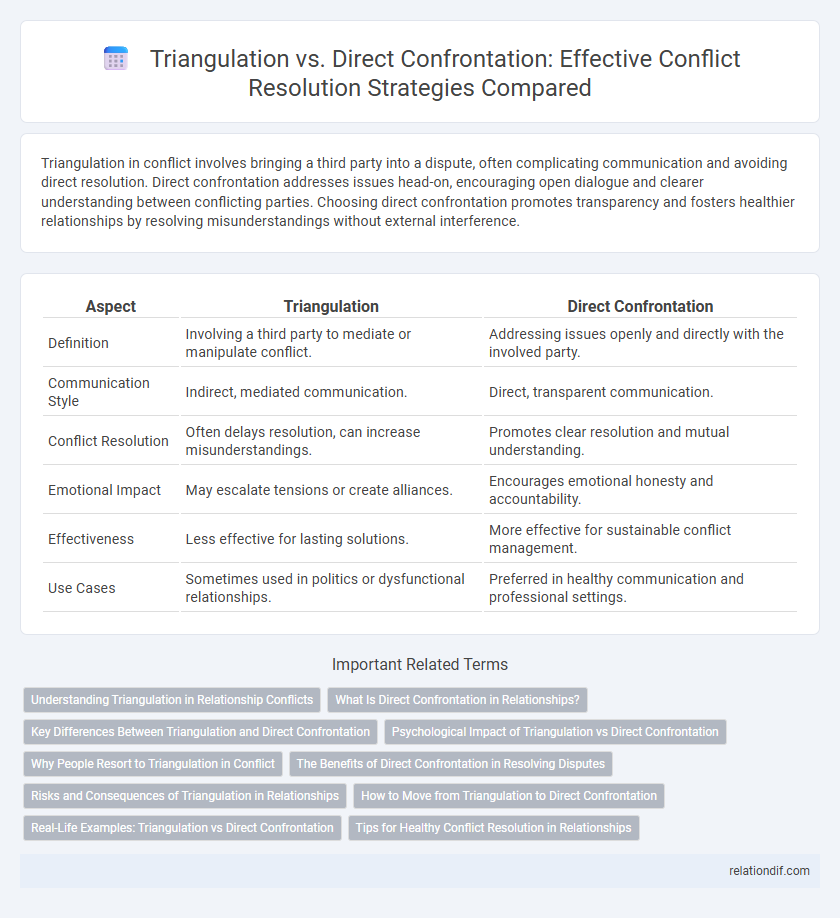Triangulation in conflict involves bringing a third party into a dispute, often complicating communication and avoiding direct resolution. Direct confrontation addresses issues head-on, encouraging open dialogue and clearer understanding between conflicting parties. Choosing direct confrontation promotes transparency and fosters healthier relationships by resolving misunderstandings without external interference.
Table of Comparison
| Aspect | Triangulation | Direct Confrontation |
|---|---|---|
| Definition | Involving a third party to mediate or manipulate conflict. | Addressing issues openly and directly with the involved party. |
| Communication Style | Indirect, mediated communication. | Direct, transparent communication. |
| Conflict Resolution | Often delays resolution, can increase misunderstandings. | Promotes clear resolution and mutual understanding. |
| Emotional Impact | May escalate tensions or create alliances. | Encourages emotional honesty and accountability. |
| Effectiveness | Less effective for lasting solutions. | More effective for sustainable conflict management. |
| Use Cases | Sometimes used in politics or dysfunctional relationships. | Preferred in healthy communication and professional settings. |
Understanding Triangulation in Relationship Conflicts
Triangulation in relationship conflicts occurs when one party involves a third person to communicate or manage tension, often bypassing direct dialogue between the primary individuals involved. This indirect approach can perpetuate misunderstandings and reduce accountability by diffusing responsibility across the parties. Understanding the dynamics of triangulation is crucial for resolving conflicts effectively, as it highlights the need for clear, direct communication to address underlying issues.
What Is Direct Confrontation in Relationships?
Direct confrontation in relationships involves addressing conflicts openly and honestly by expressing feelings, concerns, and needs without involving third parties. This approach fosters clear communication, accountability, and the opportunity to resolve misunderstandings immediately. Compared to triangulation, where a third person is drawn into the conflict, direct confrontation encourages personal responsibility and strengthens trust between the individuals involved.
Key Differences Between Triangulation and Direct Confrontation
Triangulation involves using a third party to communicate or resolve conflict, often leading to indirect and convoluted interactions, whereas direct confrontation addresses issues openly between involved parties, promoting clarity and resolution. Triangulation can create misunderstandings and power imbalances, while direct confrontation encourages accountability and honest dialogue. The key difference lies in the communication method--indirect and evasive in triangulation, direct and transparent in confrontation.
Psychological Impact of Triangulation vs Direct Confrontation
Triangulation in conflict creates confusion and anxiety by involving a third party, which often leads to inefficiency and unresolved tension. Direct confrontation, while potentially uncomfortable, fosters clearer communication and emotional resolution by addressing issues head-on. Psychological research indicates that avoidance through triangulation increases stress and feelings of helplessness, whereas direct confrontation promotes empowerment and psychological closure.
Why People Resort to Triangulation in Conflict
People resort to triangulation in conflict to avoid direct confrontation and the emotional discomfort it may cause. Triangulation often serves as a coping mechanism when individuals lack the communication skills or confidence to address issues openly. This indirect approach can create power imbalances, as it involves using a third party to mediate or manipulate the situation rather than resolving the conflict through honest dialogue.
The Benefits of Direct Confrontation in Resolving Disputes
Direct confrontation in conflict resolution promotes clear communication by addressing issues head-on, reducing misunderstandings and fostering mutual accountability. This approach minimizes the risk of triangulation, which can escalate tensions and distort the original conflict. By engaging all parties openly, direct confrontation enables faster resolution and builds stronger trust in relationships.
Risks and Consequences of Triangulation in Relationships
Triangulation in relationships increases the risk of miscommunication and misunderstandings as indirect messages often distort the original intent. This behavior fosters mistrust and resentment by excluding key individuals from open dialogue, leading to unresolved conflicts and emotional distance. Prolonged triangulation can damage relationship dynamics, causing long-term harm to emotional intimacy and collaboration.
How to Move from Triangulation to Direct Confrontation
Moving from triangulation to direct confrontation requires clear communication and establishing trust between parties involved in the conflict. Encourage individuals to address issues directly by fostering an environment of openness and accountability, reducing reliance on intermediaries. Practicing active listening and setting boundaries helps ensure conversations remain constructive and focused on resolving the underlying problem.
Real-Life Examples: Triangulation vs Direct Confrontation
In workplace conflicts, triangulation often manifests when a team member bypasses direct communication, involving a manager to address grievances instead of confronting the colleague involved, which can escalate misunderstandings. Direct confrontation, exemplified by leaders like Elon Musk resolving disputes through transparent discussions, typically leads to quicker conflict resolution and stronger trust among team members. Studies from the Harvard Business Review reveal that teams practicing open dialogue experience 30% higher collaboration and reduced interpersonal tensions compared to those relying on indirect channels.
Tips for Healthy Conflict Resolution in Relationships
Maintaining healthy conflict resolution in relationships involves prioritizing direct confrontation over triangulation, which often complicates communication by involving third parties. Clear, honest dialogue fosters trust and ensures that issues are addressed promptly and openly, reducing misunderstandings and resentment. Practicing empathy and active listening during these conversations strengthens emotional connections and promotes mutual respect.
triangulation vs direct confrontation Infographic

 relationdif.com
relationdif.com